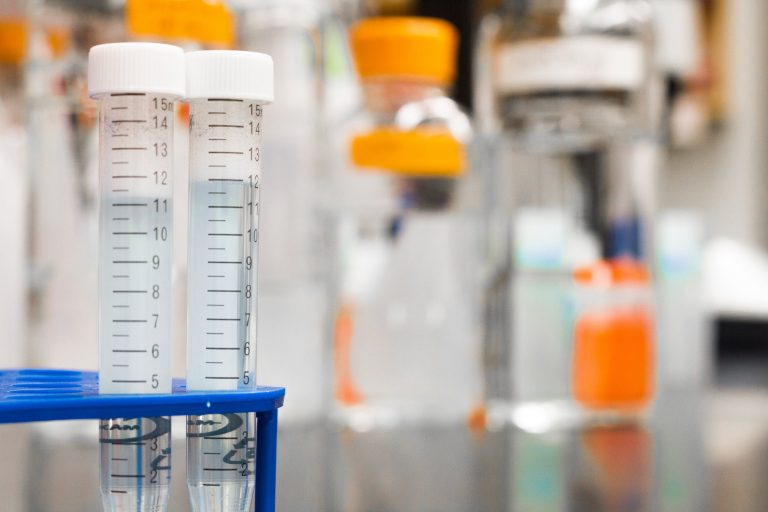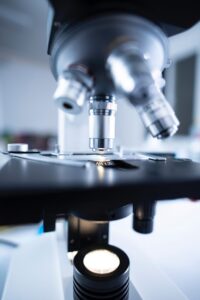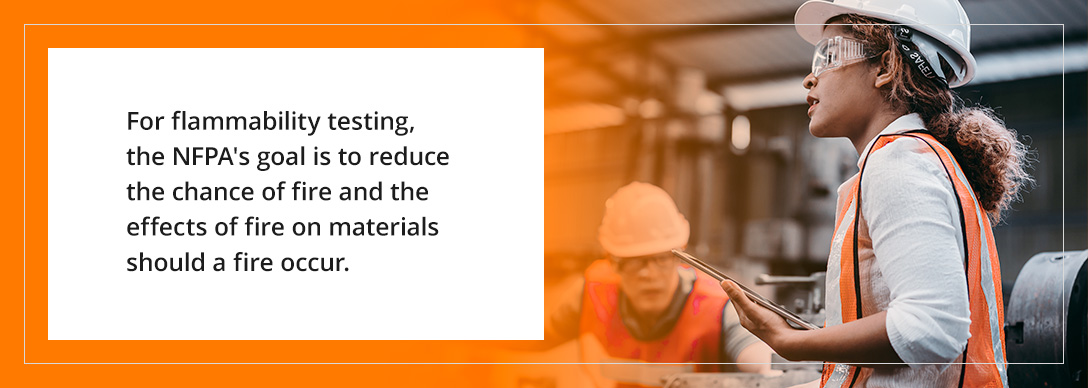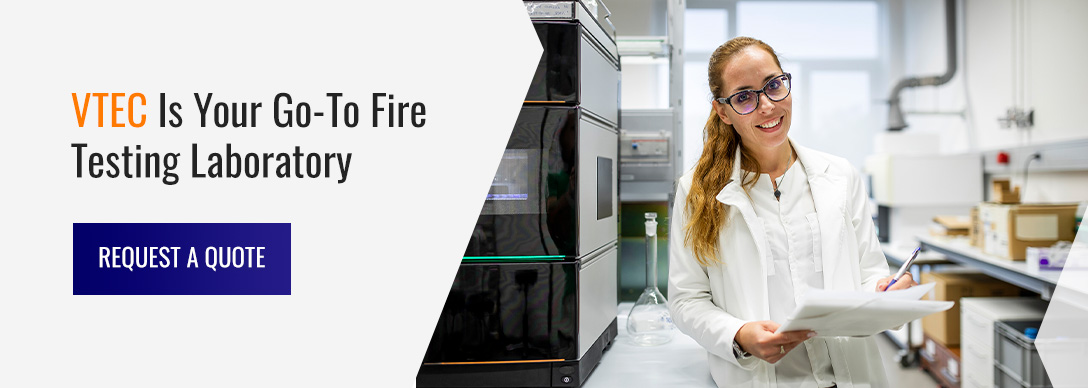Fire and Flammability Testing
Well-founded fire testing of building materials and other products is a critical part of complying with fire safety codes, industry regulations, and safety standards. Flammability tests also allow you the opportunity to learn how materials and objects behave under a multitude of different conditions.
Fire and flammability testing saves lives, and it can also boost your product's market value. Testing is a short- and long-term investment - it makes the product more versatile, more likely to reach different markets, and better understood in terms of its potential fire hazards.
Why We're the Best

We're Experts
As one of the top flammability and fire testing laboratories, we offer more than four decades of experience and possess more than a dozen accreditations, accompanied by worldwide support to clients across a range of industries, including transportation, construction, industrial, chemical, and more.
We Can Do It All
VTEC Laboratories offers a range of flammability and fire testing services - including custom services - suited for various types of material components. Ensuring your materials and products meet industry regulations and high safety standards is critical, so we aim to meet all of your fire testing needs quickly and efficiently.
Contact us to learn more about how we can assist you with your fire testing needs. We offer a two-week turnaround time on all tests. Get your results even faster with rush services.
What Is Fire and Flammability Testing?
Fire and flammability testing provides quantifiable, usable results by rigorously testing a product's resistance to heat, electrical current, open flames, and other conditions that might cause a fire.
Our fire testing laboratory works to ensure compliance with applicable local, state, and federal codes as well as product certifications and other requirements. Certified flammability testing labs are typically required to have a specialized test chambers and setups for performing various fire tests, and ours is outfitted with the proper equipment and infrastructure for safe and compliant testing.
Fire and Flammability Testing Components
Depending on the test program and the industry standards, fire and flammability tests may require additional timing and measurement devices. VTEC Laboratories can help you ensure a clean and functional product testing environment.
Our Flammability and Fire Testing Services
The following are examples of common fire and flammability tests used in different industries. VTEC Labs offers these tests and many others, including custom tests.
ASTM E119
This test determines how long specific building elements contain the fire and maintain their strength and form.
ASTM D93
This flashpoint test determines the temperature at which chemical mixes with air and combusts. This characteristic of a chemical's flammability is an essential factor in categorizing a chemical as hazardous or combustible. The Pensky-Martens closed-cup method tests chemicals in the range of 40 degrees to 370 degrees Celsius.
UL 555
UL 555 covers standards for fire dampers and is in accordance with NFPA 90A, or the National Fire Protection Association Standard for Installation of Air-Conditioning and Ventilating Systems. Fire dampers must undergo fire testing to ensure compliance with these standards. Fire dampers can be useful in the following situations.
-
- Static systems: These automatically shut down during a fire.
-
- Dynamic systems: These remain in operation during a fire.
-
- Combination fire and smoke dampers: These are used at points in HVAC systems where both a fire and smoke damper are necessary in the same place.
-
- Corridor dampers: These dampers are placed where air ducts end in the ceiling of interior hallways.
This test exposes a damper to a fire with a specified course of temperatures, then douses the flames with a fire hose to simulate a real-life situation.
ASTM D1929
Under fire and flammability testing, this test is useful for comparing the conditions under which different plastics combust, and reporting the minimum air temperature at which combustion will occur.
ASTM D635
This test compares the rates at which plastics burn and the characteristics of their burning.
ASTM D2843
It is crucial to measure the relative thickness of smoke produced by burning plastics. Such information determines visibility during a fire to check if the smoke generated obscures vital safety signs such as exit signs in a building. This test exposes plastics to controlled flame or heat so the plastic produces smoke, though it doesn't necessarily determine other characteristics of the plastic's decomposition or burning.
ASTM D2863
This fire testing method seeks to determine the minimum amount of oxygen necessary to produce a candle-like flame in a plastic to evaluate the material's flammability characteristics. It involves blowing in a mixture of oxygen and nitrogen and expressing the oxygen level as a percentage of volume. This method involves three separate procedures.
-
- Procedure A: Igniting the top surface of the material
-
- Procedure B: Propagating the ignition
-
- Procedure C: Running a comparison with a predetermined minimum oxygen percentage
By design, this flammability testing method describes the tendencies and behaviors of materials under a flame, though not necessarily under the same conditions as in a standard flame test.
ASTM E162
This test examines the surface flammability of materials by administering radiant heat with a pilot flame to evaluate how easily a material ignites and the extent of flame spread. This is typically performed for wall materials.
BSS 7239
Also known as the Boeing Safety Standard 7239, this fire test assesses the toxic gases emitted when different materials - specifically, those on an aircraft - combust.
This test is used to measure the production of particular gases: hydrogen chloride, carbon monoxide, hydrogen fluoride, nitrogen oxides, sulfur dioxide, and hydrogen cyanide.
UL 94
UL 94 is a flammability testing method that examines a material's tendency to either spread or retard flame once it has been set on fire.
SMP 800C
Also known as the Bombardier toxicity test standard, the SMP 800C measures the release of toxic gases such as carbon monoxide and dioxide, hydrogen cyanide, hydrogen chloride, hydrogen fluoride, hydrogen bromide, sulfur dioxide, and nitrogen oxides. This fire testing standard imposes limits on how many parts per million burning materials can emit, ensuring that materials used in aerospace and transportation applications meet safety thresholds for toxic gas emissions.
Industries That Need Us
Aerospace
With unprecedented advances made every day, aerospace manufacturers need reliable fire testing services more than ever. Aerospace components feature an exceptional degree of engineering precision and specification, and fire testing is imperative to ensure safety in extreme conditions.
VTEC Labs is capable of testing components and materials from all parts of the craft in our test facility in Bronx, NY. Our state-of-the-art test facility delivers expert testing services to meet the growing list of needs of aerospace manufacturers. We help your products comply with different fire test requirements, which allows them to surpass industry-mandated standards and customer expectations for factors like airflow, strength, and smoothness.
Aerospace regulation also requires reliable fire resistance and fireproof testing, which may require specific or customized tests with extremely high temperatures. Our tests for aerospace include, but are not limited to:
-
- ASTM E906: Measuring how quickly materials release heat at different rates
-
- FAA AC 20-135: Examining the fireproof and fire-resistant properties of propulsion systems
-
- SMP 800-C: The generation of toxic gas
-
- AITM 2.0005 (7.1.6): Flammability at 60 degrees
-
- AITM 2.0008: Smoke density in terms of visibility
-
- AITM 3.0005 (7.4): A test for toxicity
-
- BMS 13-48: Aircraft cable, extruded and cross-linked
-
- FAA/FAR 25.853: Ensuring compatibility with requirements for seat cushions in aircraft
-
- FAA/FAR 25.855: Fire testing for flammability in the interiors of aircraft
Automotive
Fire and flammability testing is paramount to the automotive industry, where passengers must remain safe from high temperatures and carefully controlled internal combustion processes. Various car components need flammability testing, including hoses, heat shields, filters, engine components, and composites.
Because the automotive industry is advancing rapidly, customers often need customized tests that evaluate performance under specific situations and conditions. Due to the prevalence of traffic accidents, it is imperative for compromised vehicles to be safe from fires.
Marine and Rail
The marine industry requires fire testing for such factors as materials' surface flammability, how much smoke and toxic byproducts they release during combustion, how building construction materials hold up to fire, and how products test under fire. Additionally, marine applications need to test for several variations of heat release.
Rail transportation needs many of the same tests as marine and automotive. VTEC Labs performs testing for nearly all the major railcar manufacturers and their suppliers. Our fire testing services include flame spread, smoke and toxicity, bond strength, and accelerated aging.
VTEC Labs is an industry leader in performing fire and flammability tests on all modes of transportation.
Military and Government
Many military and government industries perform fire testing on their buildings, materials, and equipment. Military personnel, government officials, and even government contractors must rely on various products to withstand the pressures they'll encounter. Flammability testing can help you address specifications for the qualification and reliability of your products.
VTEC Laboratories offers certified testing to ensure military and government materials you can trust while governing and protecting your country. Our fire and flammability tests for military and government industries include the following:
-
- NES 711: Determines the smoke index of products of combustion from small material specimens
-
- NES 713: Determines the toxicity index of products of combustion from small material specimens
-
- Acid gas: Tests the potential for sheathing or insulation material to emit corrosive gases when exposed to flames or high temperatures
-
- Fungal resistance: Tests if a material will support fungal growth in warm, humid conditions
-
- UL 1686: Measures the smoke production and spread of cable flames when electrical and optical fiber cables are exposed to fire
-
- ASTM G21: Gauges the resistance of synthetic polymeric materials to fungi
-
- MIL-DTL 24643: Cables, electric, low-smoke halogen-free, for shipboard use
-
- MIL-DTL 24640: Cables, electric, low-smoke halogen-free, for shipboard use
-
- MIL-STD-810: Tests of rugged computing equipment
-
- MIL-STD-2031: Testing for fire and toxicity
Construction and Engineering
The construction and engineering industry includes industrial and manufacturing applications, which play a prominent role in everyday life and are subject to heavy regulation and standardization. Materials need to be tested to ensure they are durable and pure enough to withstand heat from electrical short circuits, overheated surfaces, and other conditions.
VTEC Laboratories can also perform room flammability testing operations using a room with an adjustable ceiling that is 12 feet per side. Our tests for construction and engineering include the following:
-
- ASTM C1166: Fire testing to determine how flame propagates through cellular and dense elastomeric gaskets, as well as other accessories
-
- ASTM D229: Tests the rigid materials for sheets and plates in electrical insulation
-
- ASTM E84: Determines how the surfaces of building materials burn
-
- ASTM E162: Surface flammability of materials using a radiant heat energy source
-
- ASTM E648: A test to measure the critical radiant flux of systems that cover the floor, using a source of radiant heat energy
-
- DIN 4102, Part 1, Class A1: A fire test for non-combustible building materials
-
- ISO 9705: Fire testing for surface materials that takes place in a full-scale room
Chemical
The chemical industry is particularly reliant on fire and flammability testing due to the nature of its products. Whether a chemical is used for agriculture, manufacturing, consumer products, or other purposes, it will be subject to regulations and needs to be tested. Some chemical tests include the following.
-
- ASTM D93: A flashpoint test that uses a Pensky-Martens closed-cup tester
-
- ASTM D1929: The temperature at which plastics ignite
-
- ASTM D3065: Fire testing of aerosol products for flammability
-
- ASTM E659: The temperature at which a chemical ignites
-
- ASTM E681: Tests the limits of concentration for chemical flammability in gaseous form
Fire and Flammability Certifications and Standards
Specific standards, certifications, and organizations guide the fire and flammability testing process and set policy.
ASTM Standards
Formerly known as the American Society for Testing and Materials, ASTM International is the worldwide leader in the development of voluntary consensus standards. Companies, individuals, organizations and other institutions around the world use these standards to guide the development and testing of materials, including flammability testing methods.
ASTM documents detail exact requirements for the safe use and quality of materials across industries. These can include paints, metals, textiles, plastics, consumer products and petroleums.
Organizations that follow ASTM standards can prove to their stakeholders that they are providing high-quality, consistent products that follow the fire testing standards needed to reduce the risk of fire combustion and spread
NFPA
NFPA, which stands for the National Fire Protection Association, is one of the leading bodies in developing standards and consensus codes for fire safety. For flammability testing, the NFPA's goal is to reduce the chance of fire and the effects of fire on materials should a fire occur.
The documents that NFPA produces establish detailed sets of criteria including fire testing standards for designing, processing, building, servicing, and installation processes in the United States and several other countries around the world.
In short, NFPA standards help organizations with the following:
-
- Designing fire-safe products and buildings
-
- Maintaining building safeguards
-
- Improving structural safety performance
ISO Accreditations
ISO is a nongovernmental organization that develops market-relevant, consensus-based, and voluntary international standards that provide solutions and support innovation. By achieving ISO accreditations, you can earn a certification that demonstrates your services or products can meet your customers' expectations.
Here are three ISO accreditations you should know about:
-
- ISO 17020: The ISO 17020 standard is for third-party inspection bodies. It ensures organizations stay consistent and impartial in their operations, from fire and flammability testing to the handling of their structure, resources, processes, and management systems. While the standard is not specific to fire testing, it can apply to inspection bodies involved in fire testing if their scope includes such activities.
-
- ISO 17025: The ISO 17025 standard focuses on calibration services, specifically the quality management used when operating them. Certification organizations and independent labs use this standard to ensure compliance and conformity with best practices.
-
- ISO 17065: The ISO 17025 standard ensures testing labs, inspection bodies, and certification bodies correctly certify the quality of services, products, and processes across industries. When consumers see ISO 17065 accreditation and certification, they can know that the products or services they're receiving will meet all required international standards.
Other Fire & Flammability Tests From VTEC Laboratories
Need Expert Testimony?
VTEC Labs is a certified industry leader in testing, consulting, and expert testimony for situations that include fire, arson, and fire property damage. Using our expert resources, we will compile evidence and participate in expert witness projects to help settle legal disputes with evidence-driven tests.
With more than 30 years of experience, VTEC Laboratories is an expert in fire and flammability testing. We've provided companies worldwide with accurate, comprehensive tests that ensure your materials meet industry regulations and your in-house quality and safety standards.
Contact us today for fire and flammability testing and we'll show you why we're the best.
VTEC IS YOUR GO-TO FIRE TESTING LABORATORY
With more than 30 years of experience, VTEC Laboratories is an expert in flammability and fire testing. We've provided companies worldwide with accurate, comprehensive tests that ensure your materials meet industry regulations and your in-house quality and safety standards.
Receive a quote for fire and flammability testing by calling us today at 718-542-8248 or contacting us online.





